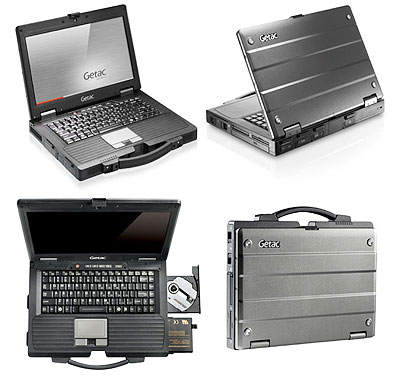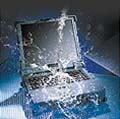|
Getac S400
Semi-rugged notebook computer offers Intel Core i3/i5 power, excellent connectivity, optional resistive multi-touch, all at a very fair price
(by Conrad H. Blickenstorfer)
On October 19, 2010, Getac announced a new addition to its growing lineup of tablet, handheld and notebook computers built to last. The S400 is a "semi-rugged" full-featured notebook computer specifically designed for use in a variety of field applications that require more toughness and durability than consumer products can provide, but not the higher weight and cost of fully ruggedized construction. Target deployment for semi-rugged systems includes utilities, field service, public safety, as well as military applications and vehicle use.

What do you get with the Getac S400? In essence a modern, full-function multi-purpose notebook computer that's significantly more durable than a consumer notebook. And also one that won't weigh you down: The S400 measures 13.7 x 10.15 inches, is just under two inches thick, and weighs about 6.5 pounds (to put it in perspective, that's about the footprint of a 15-inch MacBook Pro). The S400 has a 14-inch LCD display with the fashionably wide-format 16:9 aspect ratio and WXGA 1366 x 768 pixel resolution, which also so happens to be the same as the 720p high definition TV standard. Below you can see what the Getac S400 looks like from various angles:

The S400 is thoroughly modern under the hood as well. Getac offers two dual processor options, both from Intel's highly regarded 2010 Core processor lineup. You can select either the Core i3-350M running at 2.26GHz, or the Core i5-520M running at 2.4GHz and capable of speed bursts up to 2.93GHz. Apart from the difference in clockspeed, the higher-end i5 chip offers Turbo Boost (the ability to boost clock speed when certain conditions are met) and supports a number of advanced Intel technologies that may or may not be needed (virtualization, trusted execution, advanced AES). The S400 can support up to 8GB and comes with a speedy 320GB SATA hard disk (for certain applications, customers may want to select the optional 80GB solid state disk instead). The multimedia bay fo the S400 accommodates a Super-Multi DVD reader/writer.
The S400's standard 14-inch display is sunlight-readable, and it will do nicely in most applications. However, Getac also offers an optional even brighter display with Getac's QuadraClear display technology that uses a variety of optical coatings and measures and a very strong backlight to provide exceptional outdoor viewabilty. The 700 nits backlight of this display is several times brighter than that of consumer notebook displays that rarely offer more than about 200 nits. In addition, this display is available with Getac's unique resistive multi-touch technology that, unlike the technology used on the Apple iPad, can even be used even with gloves (see info page on Getac's multi-touch technology).
For connectivity, the S400 is well equipped, as one would expect from a business-class notebook. There are three USB 2.0 ports, a combo USB/eSATA port (used for certain high-speed external data storage devices), IEEE 1394 "Firewire", RS232 serial, gigabit LAN, VGA video, audio in and out, dock, and optional RJ11 modem port and antenna pass-through for units equipped with GPS and/or WWAN. This pretty much means that transferring data to and from the Getac S400 will never be a problem, no matter what standard is required.
For expansion, there is a PC Card Type II slot, an ExpressCard 34/54 mm slot, a Smart Card reader, and a memory card reader that supports SD cards as well as Sony's Memory Stick and Memory Stick PRO.
On the wireless side you get 802.11a/b/g/n via Intel's Centrino Advanced-N 6200 WiFi module, Bluetooth, and optional Gobi 2000 (see Qualcomm page on Gobi) and GPS. With Gobi, S400 users in the US can access AT&T, Sprint and Verizon Wireless networks without the need for different wireless modules, and they can select or change to the best carrier for any geographic area.
Since the S400 packs a significant punch with its standard voltage Core i3 or i5 processors, it needs a battery large enough to offer acceptable battery life. To facilitate that, the S400 comes with a powerful 7,800mAH smart Li-Ion power pack. This seems to be a 9-cell, 11.1 Volt pack, which would mean about 87 watt-hours of capacity -- plenty enough to expect very good battery life from the S400.
As far as ruggedness goes, what does Getac mean by "semi-rugged"? The S400 press release offers the following quote by Getac president Jim Rimay: "Where the impact of a speed bump, the vibration of a diesel engine and the cold winter temperature would wreak havoc on a traditional consumer grade laptop, the S400 excels." In terms of specs, this means an operating temperature range of 32 to 113 degrees Fahrenheit, the ability to survive a 2.5 foot drop, and MIL-STD-810G compliance for vibration testing. The unit is IP5x rated, which means it's pretty much protected against dust, but without making any claims to protection against liquids (Getac does offer a water-resistant keyboard). As far as construction goes, Getac refers to its new "KryptoShell" housing material, but without explaining what it is and offers. Despite wishing for some more detailed ruggedness specs, having had ample experience with Getac computers over the years, we're confident that the S400 is well made and will hold up well in its intended applications.
Security is addressed via a combination of hardware and software measures, including a finger print reader (optional), a Smart Card reader, TPM 1.2, a cable lock slot, Intel security technologies available through the new i5 chip, as well as BIOs, password and software utility settings.
One question that comes to mind is how the new S400 compares with the company's P470 model. Both have 14-inch displays, similar equipment, and they are in the same price class. The S400 has more modern electronics, but the P470 is labeled rugged whereas the S400 is listed as semi-rugged. This may require a bit of clarification.
Overall, the Getac S400 represents everything a mobile professional could wish for in a state-of-the-art notebook computer. It offers excellent performance, has excellent connectivity, a large-enough display in today's 16:9 aspect ratio, enough extra ruggedness and protection to make it suitable for use in situations where consumer notebooks will not survive, and attractive options such as a super-bright display with glove-enabled multi-touch and provider/technology-independent wide area wireless operation via Gobi 2000.
|








